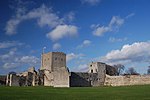Port Solent

Port Solent is the commercial business name of a housing and leisure development located in the Paulsgrove suburb of the English city of Portsmouth, Hampshire, comprising a marina, a housing estate, shopping and leisure facilities.The Port Solent development was built during the late 1980s on reclaimed land taken from the east side of Paulsgrove Lake in Portsmouth Harbour, specifically between the north of Horsea Island and the shoreline of Paulsgrove Quay in Paulsgrove. Facilities for residents and visitors include a multiscreen cinema, health club, and restaurants and shops along a precinct known as The Boardwalk. The marina is owned and managed by Premier Marinas.Port Solent was officially opened on 29 July 1988 by H.R.H. Anne, The Princess Royal. The first boat to use Port Solent was the 36-foot cutter Lively Lady, sailed by Sir Alec Rose (1908-1991).Port Solent is politically within the Paulsgrove electoral ward and the Portsmouth North UK Parliament constituency. The main entrance road junction into the Port Solent development is built almost exactly over the site of the former Paulsgrove Quay shoreline.
Excerpt from the Wikipedia article Port Solent (License: CC BY-SA 3.0, Authors, Images).Port Solent
Port Way, Portsmouth Port Solent
Geographical coordinates (GPS) Address Nearby Places Show on map
Geographical coordinates (GPS)
| Latitude | Longitude |
|---|---|
| N 50.842 ° | E -1.1 ° |
Address
Port Way
PO6 4SU Portsmouth, Port Solent
England, United Kingdom
Open on Google Maps







